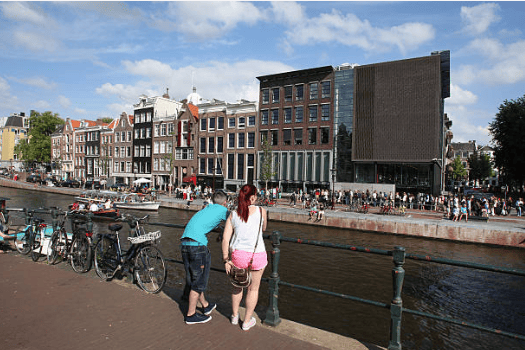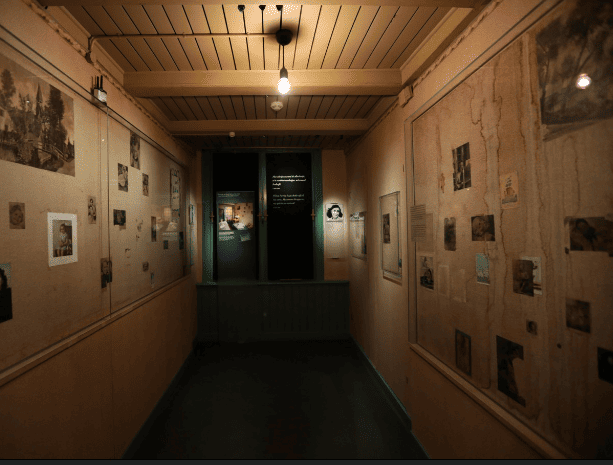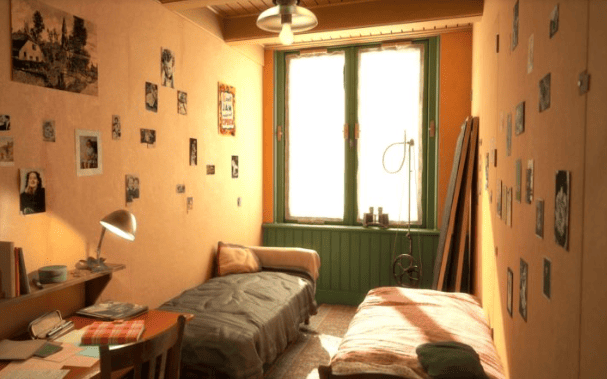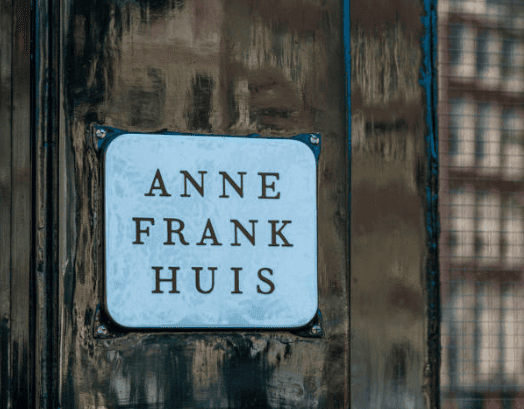The Netherlands is an attractive travel destination, known for its modern, clean cities and a unique emotional connection with Indonesians. Among its many beautiful tourist sites, one stands out as a somber reminder of the lives impacted by World War II. The Anne Frank House, located in Amsterdam, is a must-visit for those interested in Dutch history.

The Anne Frank House, a museum dedicated to the German-Jewish diarist Anne Frank, is located in a canal house in Amsterdam, Netherlands. It was here that Anne, her family, and four other Jews hid from the Nazis from 1942 until they were betrayed and discovered by the Gestapo in 1944. The museum opened in 1960 and also includes two adjacent buildings.
Anne’s father, Otto Frank, a German businessman, moved his family—his wife and two daughters—from Germany to Amsterdam before the outbreak of World War II to escape Nazi persecution. In 1940, he relocated his food products business to 263 Prinsengracht, a canal house originally built in 1635. The building featured a rear annex, now known as the Secret Annex, hidden from view by surrounding structures. It was in this concealed space that the group of eight lived in isolation, never venturing outside and relying on supplies brought by friends and some of Otto’s employees. After the Germans raided the house, they emptied it, but a staff member named Miep Gies managed to rescue Anne’s diary, which she had kept hidden. Gies later returned the diary to Otto, the only survivor from their group sent to the extermination camp.
Otto dedicated himself to editing and publishing the diary, which was first published in Dutch in 1947. The Anne Frank Foundation was established in 1957, with Otto’s cooperation, to preserve the canal house as a museum. The initial number of visitors was high, leading to renovations and expansions of the museum in 1999.
Anne Frank’s house is situated in the Prinsengracth area, which translates to “Prince’s Canal,” and is part of Amsterdam’s UNESCO World Heritage List. This narrow, tall building, commonly called a canal house, always has a line of visitors eager to see the biographical museum. Inside, Anne Frank and her family once hid from Nazi persecution during World War II. The house became a museum in 1960, largely due to the popularity of Anne Frank’s diary, which was found in this very place.

The Frank family lived in this historic house. Anne’s father, Otto Frank, managed a spice company called Opekta and Pectacon and used the house as both a warehouse and office, as well as their family residence. When Nazi soldiers began hunting Jewish people in Europe, Anne, her parents, her sister, and four others hid in a secret room at the back of the house, called the Secret Annex or Achterhuis in Dutch.
For two years and one month, the family lived in the small, 46-square-meter room. During this time, Anne documented her life in hiding from the Nazis in her diary. Tragically, the Nazis eventually discovered their location and deported the Frank family to Auschwitz concentration camp in Poland. Anne and her family perished in the camp, with only her father, Otto, surviving.

When Anne Frank was detained, a few Dutch individuals who had worked for her father saved some of the family’s belongings, including Anne’s diary. After World War II, Anne’s diary was returned to her father, who subsequently published it and established the Anne Frank Foundation to raise funds to repurchase the family’s house.
The museum, opened on May 3, 1960, allows visitors to see the Secret Annex where Anne and her family hid, concealed behind a bookshelf. Anne’s diary is displayed in the house, along with two other works she wrote, “Favourite Quote Notebook” and “Tales Book.”
The Anne Frank House has been preserved in its original condition from before World War II. The ground floor served as the warehouse, the first floor as her father’s office, and the upper floors as the family’s living space, including Anne’s room, her parents’ room, the dining area, kitchen, and family room.

Next door to the Anne Frank House is a café and bookstore, where visitors can conclude their tour and view the Anne Frank exhibition. The museum is open daily from 9 a.m. to 10 p.m. (April – October) and from 9 a.m. to 7 p.m. (November – March). Tickets are available online or at the museum and cost €9 per person, approximately 142,000 IDR. To visit the Anne Frank House, it’s recommended to purchase tickets online, as only online ticket holders are admitted between 9 a.m. and 3:30 p.m., with ticket office sales starting at 3:30 p.m.

площадка для продажи аккаунтов магазин аккаунтов
гарантия при продаже аккаунтов marketplace-akkauntov-top.ru/
покупка аккаунтов https://magazin-akkauntov-online.ru
перепродажа аккаунтов ploshadka-prodazha-akkauntov.ru/
купить аккаунт с прокачкой перепродажа аккаунтов
маркетплейс аккаунтов https://kupit-akkaunt-top.ru
гарантия при продаже аккаунтов платформа для покупки аккаунтов
Account exchange Social media account marketplace
Account Sale Social media account marketplace
Purchase Ready-Made Accounts Account Purchase
Account Market Marketplace for Ready-Made Accounts
Profitable Account Sales Account Market
Sell Account Online Account Store
Guaranteed Accounts Profitable Account Sales
Profitable Account Sales Database of Accounts for Sale
Guaranteed Accounts https://accountsmarketplaceonline.com
Account marketplace Account Buying Service
Account exchange https://socialmediaaccountsale.com/
gaming account marketplace database of accounts for sale
account market buy pre-made account
account exchange account trading platform
website for buying accounts profitable account sales
account selling platform account buying service
account exchange online account store
ready-made accounts for sale online account store
account exchange secure account sales
account selling service discountaccountsmarket.com
guaranteed accounts account exchange service
account trading platform buy account
ready-made accounts for sale account trading platform
ready-made accounts for sale secure account purchasing platform
secure account sales guaranteed accounts
verified accounts for sale sell account
secure account sales buy-social-accounts.org
account marketplace account purchase
sell accounts marketplace for ready-made accounts
account selling service website for selling accounts
verified accounts for sale profitable account sales
secure account purchasing platform account trading
social media account marketplace account market
buy account sell pre-made account
sell accounts account trading platform
account buying service https://accounts-store.org
sell account sell pre-made account
account marketplace find accounts for sale
online account store account exchange service
account trading https://accounts-offer.org
sell account https://accounts-marketplace.xyz
account trading platform accounts market
account buying platform https://social-accounts-marketplaces.live
buy accounts https://accounts-marketplace.live/
gaming account marketplace https://social-accounts-marketplace.xyz
sell account account marketplace
website for buying accounts account marketplace
social media account marketplace https://social-accounts-marketplace.live
account trading platform account marketplace
verified accounts for sale https://accounts-marketplace.online/
account exchange https://accounts-marketplace-best.pro
покупка аккаунтов https://akkaunty-na-prodazhu.pro/
продать аккаунт rynok-akkauntov.top
продать аккаунт https://kupit-akkaunt.xyz/
маркетплейс аккаунтов https://akkaunt-magazin.online/
продажа аккаунтов https://akkaunty-market.live/
маркетплейс аккаунтов kupit-akkaunty-market.xyz
купить аккаунт akkaunty-optom.live
продать аккаунт https://online-akkaunty-magazin.xyz/
продажа аккаунтов https://akkaunty-dlya-prodazhi.pro/
продать аккаунт https://kupit-akkaunt.online
facebook ad account buy https://buy-adsaccounts.work
facebook ads account buy https://buy-ad-accounts.click
fb account for sale https://buy-ad-account.top
buy facebook advertising accounts https://buy-ads-account.click/
buying fb accounts https://ad-account-buy.top
buying facebook ad account https://buy-ads-account.work
facebook ad account for sale buy facebook ads account
buy fb account facebook ad account for sale
В этой статье-обзоре мы соберем актуальную информацию и интересные факты, которые освещают важные темы. Читатели смогут ознакомиться с различными мнениями и подходами, что позволит им расширить кругозор и глубже понять обсуждаемые вопросы.
Ознакомиться с деталями – https://medalkoblog.ru/
buy facebook advertising facebook accounts to buy
sell google ads account https://buy-ads-account.top
adwords account for sale https://buy-ads-accounts.click
buy facebook accounts for ads https://buy-accounts.click
google ads agency account buy https://ads-account-for-sale.top
buy google ads accounts https://ads-account-buy.work
buy google ads account https://buy-ads-invoice-account.top
buy google ads account google ads agency account buy
buy verified google ads account google ads agency accounts
buy old google ads account sell-ads-account.click
buy verified google ads account google ads agency accounts
buy facebook business manager verified buy-business-manager.org
google ads agency accounts https://buy-verified-ads-account.work
facebook bm for sale https://buy-bm-account.org/
buy fb business manager buy facebook verified business manager
buy fb business manager https://buy-verified-business-manager-account.org/
fb bussiness manager https://buy-verified-business-manager.org
facebook business manager account buy https://business-manager-for-sale.org
buy facebook bm facebook verified business manager for sale
buy facebook bm account https://buy-bm.org/
buy facebook business manager verified https://verified-business-manager-for-sale.org
buy business manager facebook buy facebook verified business manager
tiktok agency account for sale https://buy-tiktok-ads-account.org
buy tiktok ads https://tiktok-ads-account-buy.org
tiktok ads account for sale https://tiktok-ads-account-for-sale.org
buy tiktok ads https://tiktok-agency-account-for-sale.org
buy tiktok business account https://buy-tiktok-ad-account.org
buy tiktok ad account https://buy-tiktok-ads-accounts.org
tiktok agency account for sale https://buy-tiktok-business-account.org
buy tiktok ads accounts https://buy-tiktok-ads.org
tiktok ads account buy https://tiktok-ads-agency-account.org
¡Hola, participantes del azar !
Casino online extranjero sin restricciones legales – https://casinoextranjerosespana.es/# casinos extranjeros
¡Que disfrutes de asombrosas botes espectaculares!
¡Saludos, buscadores de tesoros!
Mejores casinos extranjeros 2025 para espaГ±oles – п»їhttps://casinosextranjerosenespana.es/ п»їcasinos online extranjeros
¡Que vivas increíbles recompensas sorprendentes !
¡Hola, buscadores de riqueza !
Casino por fuera de EspaГ±a con crupieres reales – https://www.casinoonlinefueradeespanol.xyz/ casinos online fuera de espaГ±a
¡Que disfrutes de asombrosas tiradas afortunadas !
¡Saludos, estrategas del riesgo !
Todo lo nuevo en casinoextranjerosenespana.es este mes – https://casinoextranjerosenespana.es/# casino online extranjero
¡Que disfrutes de triunfos épicos !
¡Saludos, aventureros del riesgo !
casino online extranjero sin restricciones de paГs – п»їhttps://casinosextranjero.es/ casinosextranjero.es
¡Que vivas increíbles victorias épicas !
¡Hola, usuarios de sitios de apuestas !
Casinos extranjeros con torneos exclusivos de pГіker – п»їhttps://casinoextranjero.es/ casinos extranjeros
¡Que vivas jugadas asombrosas !
¡Bienvenidos, fanáticos del azar !
Casino fuera de EspaГ±a con mГ©todos seguros – п»їhttps://casinoporfuera.guru/ casinoporfuera
¡Que disfrutes de maravillosas movidas brillantes !
¡Hola, seguidores de la aventura !
GuГa de acceso a casinos online extranjeros legales – п»їhttps://casinosextranjerosdeespana.es/ mejores casinos online extranjeros
¡Que vivas increíbles jugadas espectaculares !
¡Saludos, descubridores de tesoros!
casinosonlinefueraespanol con bonos en criptos – https://www.casinosonlinefueraespanol.xyz/ casinos fuera de espaГ±a
¡Que disfrutes de momentos irrepetibles !
¡Bienvenidos, usuarios de sitios de azar !
Casino fuera de EspaГ±a con giros sin condiciones – п»їhttps://casinofueraespanol.xyz/ casino online fuera de espaГ±a
¡Que vivas increíbles logros extraordinarios !
?Hola, aventureros del desafio !
casino online fuera de EspaГ±a adaptado a todos – п»їhttps://casinosonlinefueradeespanol.xyz/ casinosonlinefueradeespanol
?Que disfrutes de asombrosas exitos sobresalientes !
Hello protectors of healthy air !
Best Purifier for Smoke – Tested by Experts – https://bestairpurifierforcigarettesmoke.guru/# smoke air purifier
May you experience remarkable tranquil settings !
¡Saludos, participantes del reto !
Mejores casinos online extranjeros con torneos diarios – https://www.casinoextranjerosdeespana.es/ casinoextranjerosdeespana.es
¡Que experimentes maravillosas tiradas afortunadas !
¡Hola, jugadores expertos !
Casino online sin licencia sin verificaciГіn bancaria – http://casinosinlicenciaespana.xyz/ casinosinlicenciaespana.xyz
¡Que vivas increíbles instantes únicos !
¡Bienvenidos, cazadores de premios extraordinarios!
Casinos sin licencia espaГ±ola sin verificaciГіn KYC – https://mejores-casinosespana.es/ casino sin licencia espaГ±ola
¡Que experimentes maravillosas movidas destacadas !
¡Saludos, buscadores de fortuna escondida !
Casino online sin licencia y anГіnimo – https://www.audio-factory.es/ casino sin licencia espaГ±a
¡Que disfrutes de asombrosas botes sorprendentes!
¡Saludos, cazadores de recompensas excepcionales!
Juegos populares en casinos sin licencia EspaГ±a – http://www.emausong.es/ casino online sin registro
¡Que disfrutes de increíbles recompensas únicas !
¡Hola, aventureros de sensaciones intensas !
Casino sin registro y retiro en el mismo dГa – http://www.casinosonlinesinlicencia.es/ п»їcasinos sin licencia en espaГ±a
¡Que vivas increíbles jackpots impresionantes!
Greetings, adventurers of hilarious moments !
Adult joke collections – never boring – http://jokesforadults.guru/# best jokes adult
May you enjoy incredible surprising gags!
¡Saludos, seguidores de la emoción !
Bonos de bienvenida casino sin depГіsitos – http://bono.sindepositoespana.guru/ bonos de bienvenida casino
¡Que disfrutes de asombrosas tiradas exitosas !
Hello ambassadors of well-being !
Looking for the best smoke eater for home? These devices actively remove airborne chemicals left by smoking. The best smoke eater for home includes quiet operation and sleek design.
Install a dedicated air filter for smoke in rooms where smoke gathers frequently. It quickly absorbs particles and leaves behind clean, fresh air.air purifier for cigarette smokeAn air filter for smoke is essential for any smoking household.
Air purifier smoking odor control at home – п»їhttps://www.youtube.com/watch?v=fJrxQEd44JM
May you delight in extraordinary remarkable freshness !
¿Saludos exploradores de la suerte
Los mejores casinos europeos permiten invitar amigos con enlaces personalizados que otorgan recompensas a ambos. Es una forma de crecer la comunidad. casinos europeos Jugar en grupo tambiГ©n tiene ventajas.
Casino Europa lanza campaГ±as mensuales de concienciaciГіn sobre juego responsable con consejos prГЎcticos. Estas campaГ±as educan sin ser intrusivas. La prevenciГіn tambiГ©n es parte del servicio.
п»їGuГa completa sobre casinos online europeos con bonos activos – п»їhttps://casinosonlineeuropeos.guru/
¡Que disfrutes de grandes jugadas !